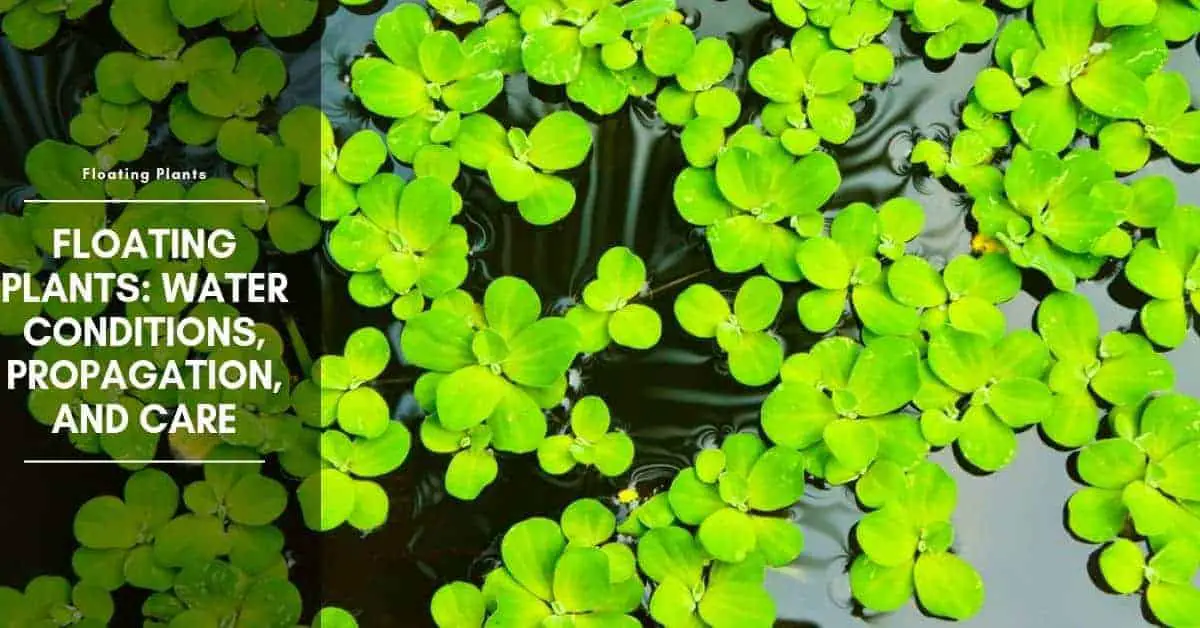Aquarium floating plants are chosen less for their appearance than those growing in the main body of the tank, and more for their function. They provide spawning sites and food for many fish species, and also give cover and help to diffuse harsh aquarium lighting.
Floating freshwater aquarium plants vary widely in both size and leaf shape, and some grow on land as well as in water. Currents in the tank have a marked effect on the distribution of floating plants, so you may have to adjust the filter outlet to achieve an even spread.
As a general rule, floating plants are only offered for sale on a seasonal basis. The two main exceptions to this are Crystalwort (Riccia fluitans) and Java Moss (Vesicularia dubyana). Both of these grow readily in aquaria and, once you have them established, form large masses, sometimes to the point of becoming a nuisance as they deprive other plants of light.
Although it is not strictly a floating plant, Java Moss is included here because it can grow well without being attached to anything. Most commonly, it is found growing from wood, rocks, and bark. If growing on wood, it will even flourish above the waterline, provided the humidity is high enough.
Clumps of this plant should be split if they become too large. Crystalwort forms large floating mats at, and just below, the water surface. It is highly prized by aquarists because it forms a natural spawning site, fry nursery, and hiding place for small fish.
Indeed, any of the plants with long, flowing root systems perform a similar function, for example, Water Lettuce (Pistia stratiotes) and Indian Fern (Ceratopteris thalictroides).
Fish make good use of the roots and broad leaves to lay eggs, while bubble-nest builders such as the gouramis find them a useful foundation for their constructions. Crystalwort will also anchor itself to wood and stones and can grow out of the water in the right circumstances.
Only one floating plant is able to root itself in the substrate – the Indian Fern. The Water Hyacinth (Eichhornia crassipes) is usually available in summer when it is a popular purchase for garden ponds. These tropical species have large, fleshy leaves and a thickened, spongy, fibrous stem that retains the air.
It propagates by sending outshoots. Though it is too large for the normal tank with a hood, it is ideal for a heated indoor pond or open-topped aquarium, where, if conditions are favorable, it will also flower. Whatever floating plants you are using, you should ensure that enough light can still reach the lower levels of the aquarium, otherwise, the plants in the substrate may die.
In tanks with a hood, it is also important to maintain a high level of humidity above the water surface; this prevents the leaves of plants such as the Water Lettuce from drying up and turning brown. All floating plants are delicate, so water movement should be extremely slow or even non-existent.
A powerful flow of water will batter and bruise the plants and break them up.
Propagation
The floating plants reproduce by various strategies. The Water Lettuce produces runners, which may be divided up once the daughter plants are large enough. The Butterfly Fern (Salvinia auriculata) produces branches that can be broken off to form new plants.
API STRESS COAT Aquarium Water Conditioner 16-Ounce Bottle
29% OffAPI STRESS ZYME Freshwater and Saltwater Aquarium Cleaning Solution 16-Ounce Bottle
Tetra Chlorine Remover 3.38 Ounces, Conditions Aquarium Water for Use in Aquariums, 100ml
$8.99 (as of June 20, 2025 02:01 GMT +03:00 - More infoProduct prices and availability are accurate as of the date/time indicated and are subject to change. Any price and availability information displayed on [relevant Amazon Site(s), as applicable] at the time of purchase will apply to the purchase of this product.)Crystalwort is an aquatic form of liverwort, whose thallus (plant body) forks frequently to form thick clumps. If these are broken up, each piece has the ability to form a new plant. When grown terrestrially, it produces spore capsules.
Duckweed also reproduces vegetatively. Indeed, it seems to multiply before your very eyes, with a new plant being produced every 30-40 hours.
The Indian Fern produces adventitious buds, which develop into daughter plants on the older leaves. You should let them develop to about 1.5 inches (4cm), and then either plant them in the substrate or allow them to float free.
Can I add floating plants in a fish tank?
Floating plants offer fish several advantages. The plants provide welcome
places to lay eggs and good hiding places for baby fish. In addition, they compete with troublesome algae.
Floating plants also subdue very bright aquarium lighting, which suits fish like bristlenose catfish that prefer rather low light.
Suitable floating plants for fish
Suitable floating plants for fish include:
- Salvinia (Salvinia natans),
- Crystalwort (Riccia Fluitans)
- Water Lettuce (Pistia stratiotes).
Although fish have no problems with floating plants, other aquarium plants can suffer because of them. Make sure that the floating plants never cover more than a third of the water surface. Otherwise, plants deeper in the tank will not receive enough light and may become stunted.
Here Are Some Of The Best Floating Aquarium Plants
Water Lettuce (Pistia)
- ORIGINS Abundant in waterways in tropical and subtropical parts of the world.
- SIZE Leaves can be up to 4 in (10 cm) in length.
- WATER Temperature 72–86°F (22–30°C); soft (50–100 mg/l) and around neutral (pH 6.5-7.5).
- PROPAGATION Break off the plantlets that develop on the stem-like stolons.
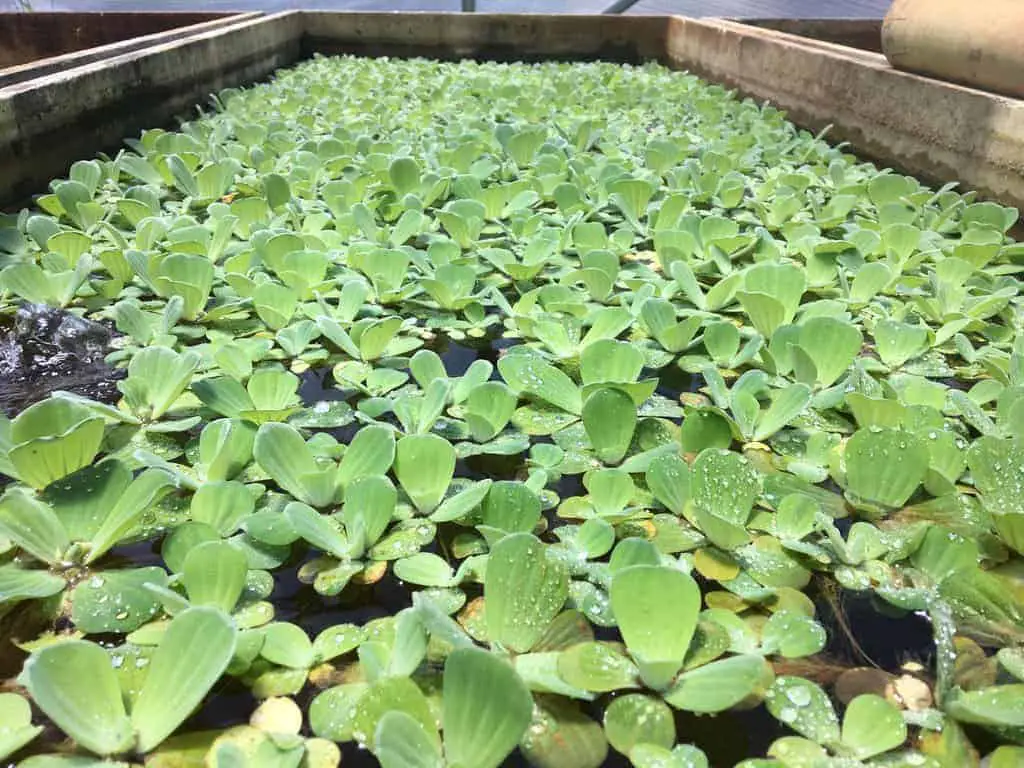
The leaf clusters of this floating plant are lettuce-like in appearance. The tiny flowers emerge in the axils, between the leaf and stalk, while the trailing roots – which extend down to a depth of 30 cm (12 in) – may be used as spawning sites by some egg-laying fish. Good lighting is vital for the successful spread of the plant, which grows fast under favorable conditions. Prevent condensation from dripping onto the leaves because the plant will rot.
Azolla caroliniana (water velvet)
- ORIGINS From the U.S. to South America; introduced to Europe in the 1870’s, and now found wild in some areas.
- SIZE Leaves each measure about 0.5 in (1.5 cm).
- WATER Temperature 68–86°F (20–30°C); hard (100–150 mg/l) and around neutral (pH 6.5-7.5).
- PROPAGATION Reproduces asexually, so simply divide an existing clump.
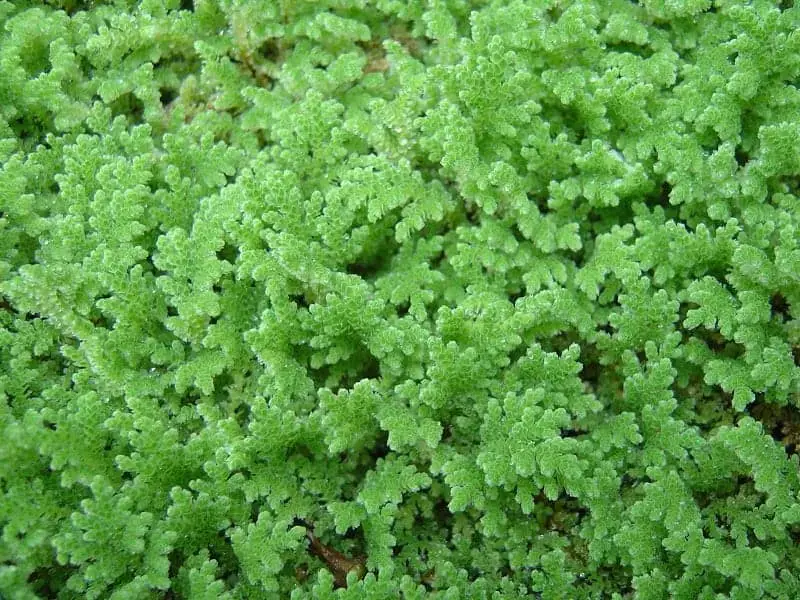
Azolla caroliniana can appear bright red under intense lighting, but more usually it will be bright green, as seen above. This plant will soon spread over the surface of an aquarium and is a useful supplement to the diet of vegetarian fish. It also provides support for the nests of bubble-nesting species, such as gouramis, and serves as a retreat for fry, which may find food among its trailing roots.
Amazon Frogbit (Limnobium laevigatum)
- ORIGINS From Mexico through Central America to Paraguay in South America.
- SIZE Leaf diameter is 1–2 in (2.5–5 cm).
- WATER Temperature 68–86°F (20–30°C); soft (50–100 mg/l) and around neutral (pH 6.5-7.5).
- PROPAGATION Split up existing plants; the divisions will grow rapidly.
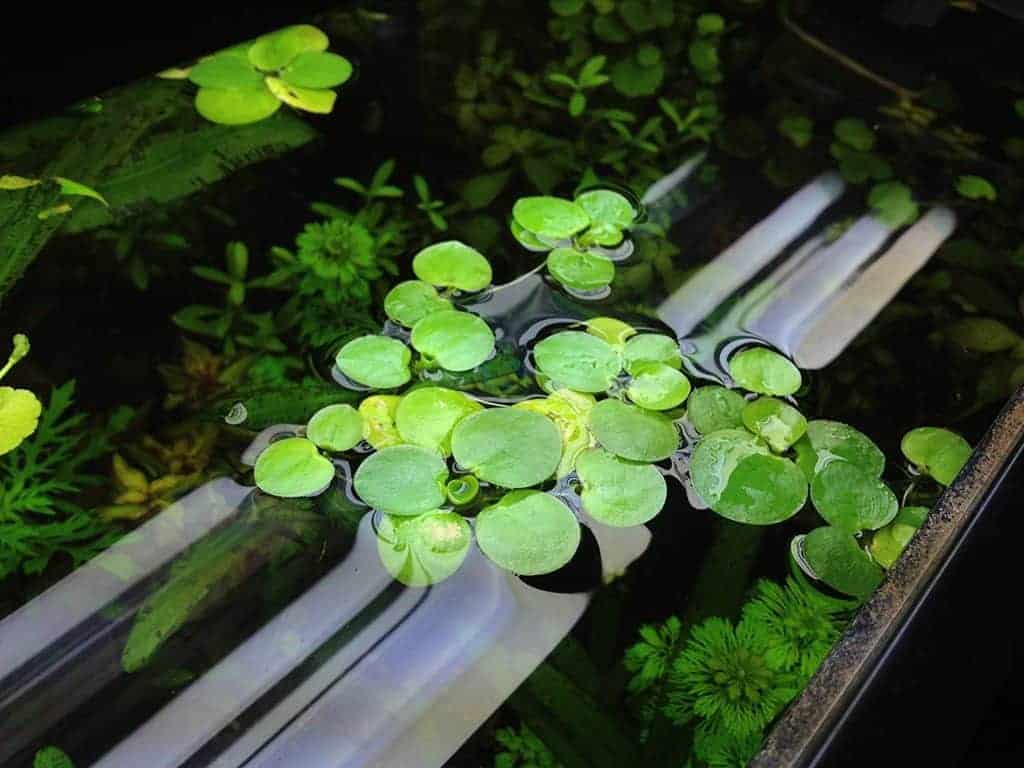
The rosette-shaped leaves of Amazon Frogbit are paler underneath and sometimes display dark markings on top. They are able to float thanks to their spongy, air-filled structure, which gives them a slightly swollen, convex appearance. Aquarium strains are female, and although they flower quite readily, there is no likelihood that they will set seed in the absence of the male flower’s pollen.
Butterfly Fern (Salvinia auriculata)
- ORIGINS Found widely in waterways from Mexico south as far as Paraguay in South America.
- SIZE Leaves are 1 in (2.5 cm) long, 0.5 in (1.25 cm) wide.
- WATER Temperature 64–77°F (18–25°C); soft (50–100 mg/l) and around neutral (pH 6.8-7.2).
- PROPAGATION Simply break up the branches formed by this fern.
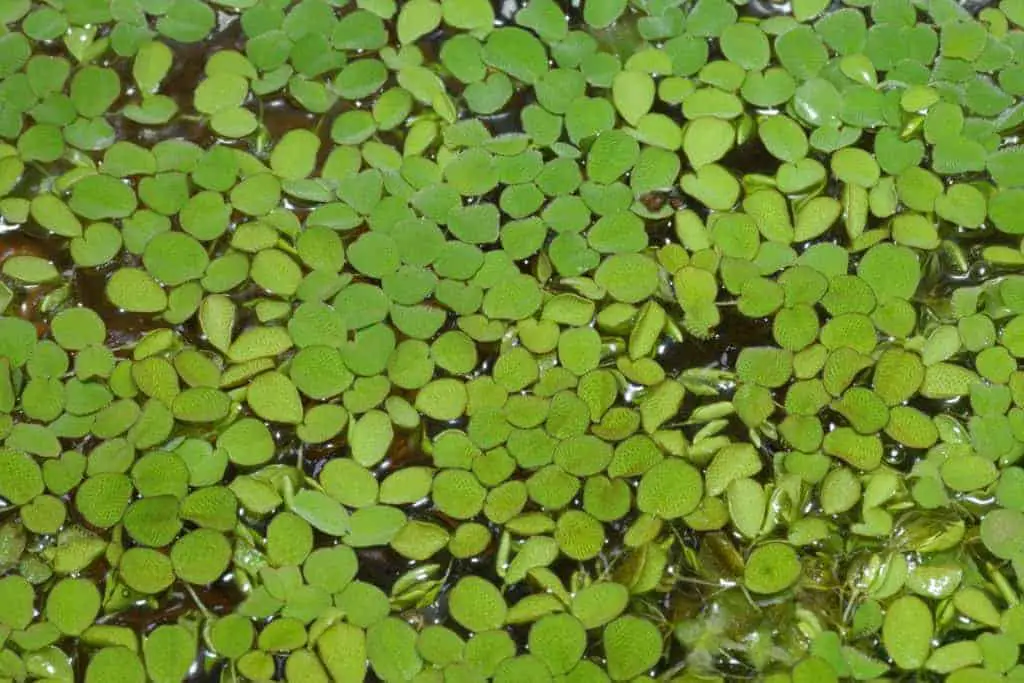
This is another species for which bright lighting is very important. If the tank has a glass cover, it must be tilted slightly so that condensation droplets do not fall onto the ferns, because this will cause the plants to rot.
It may occasionally be necessary to thin out the growth because Butterfly Fern can spread rapidly into a dense mat that will prevent light from reaching other plants beneath.
Duckweed (Lemna minor)
- ORIGINS Found throughout the world in both temperate and tropical regions.
- SIZE Leaves are small, measuring about 0.2 in (5 mm).
- WATER Temperature 41-86°F (5–30°C); soft (50–100 mg/l) and around neutral (pH 6.5-7.2).
- PROPAGATION Split off a few pieces from a mat; they will soon start to replicate
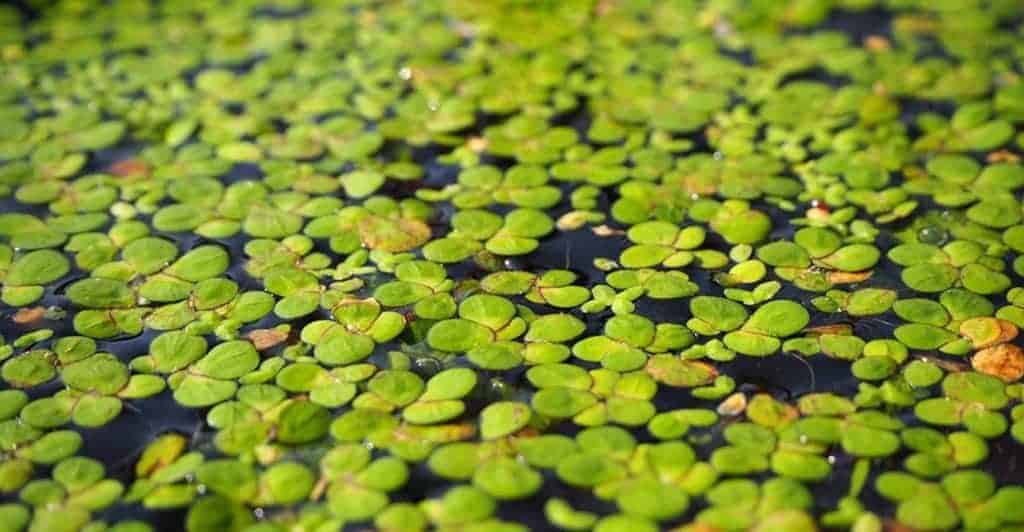
Duckweed grows under a wide range of conditions, even in an unlit aquarium, provided that it receives some natural light. This floating plant is a useful addition to a rearing tank and can serve as a food source for vegetarian fish. If there are no plant-eaters to keep its growth in check, remove some of the duckweed with a net to prevent it from choking the surface.
Watermeal (Wolffia arrhiza)
- ORIGINS Found throughout the world, in both temperate and tropical regions outside polar areas.
- SIZE Tiny leaves measure about 0.05 in (1 mm).
- WATER Temperature 59–82°F (15–28°C); soft (50–100 mg/l) and around neutral (pH 6.5-7.5).
- PROPAGATION Split off a few pieces from a mat; they will soon start to replicate.
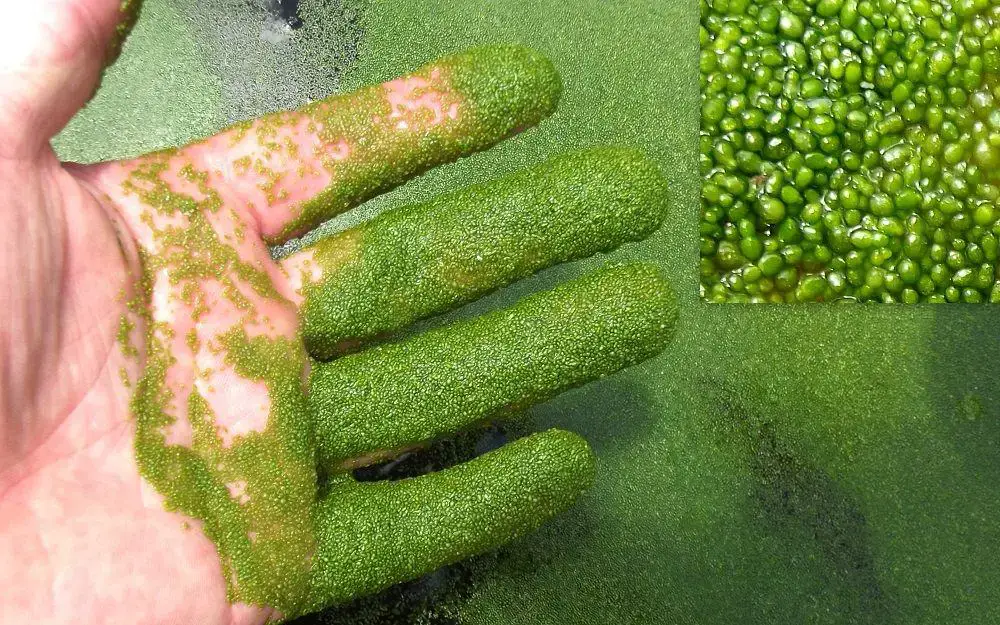
Watermeal is the smallest flowering plant known. Although the genus Wolffia comprises eight recognized species, they are all very similar in appearance. Watermeal is easy to grow, with its green coloration turning reddish under bright light. A ready supply of trace elements in the water will encourage rapid growth.
Liverwort (Riccia fluitans)
- ORIGINS Another widely distributed species, occurring in parts of the Americas, Asia, and Europe.
- SIZE Leaves typically no more than 0.08 in (2 mm).
- WATER Temperature 68–82°F (20–28°C); hard (100–150 mg/l) and around neutral (pH 6.5-7.5).
- PROPAGATION Break off a piece from an existing clump to add to a new tank.
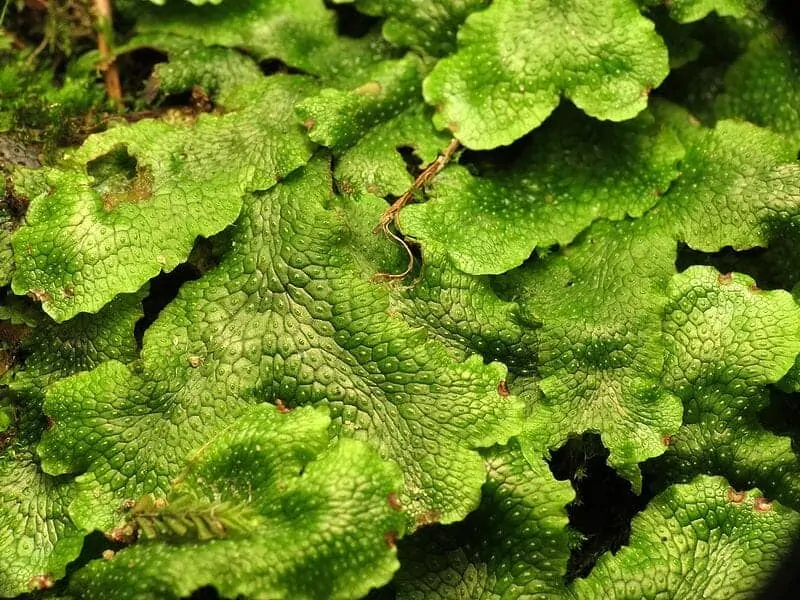
Liverwort differs from other floating water plants in that it grows just below the surface, where it ultimately forms large balls. It can also be grown out of water in damp mud. It will thrive under relatively hard water conditions in the aquarium. Liverwort is especially valuable in tanks housing livebearers, providing fry with a safe refuge from the predatory attentions of other tank occupants.
Water-sprite (Ceratopteris thalictroides)
- ORIGINS Grows widely throughout the world’s tropical regions.
- SIZE Up to 24 in (60 cm) tall when rooted.
- WATER Temperature 72–86°F (22–30°C); soft (50–100 mg/l) and slightly acidic (pH 6.5).
- PROPAGATION Young plants develop on the edges of existing leaves.
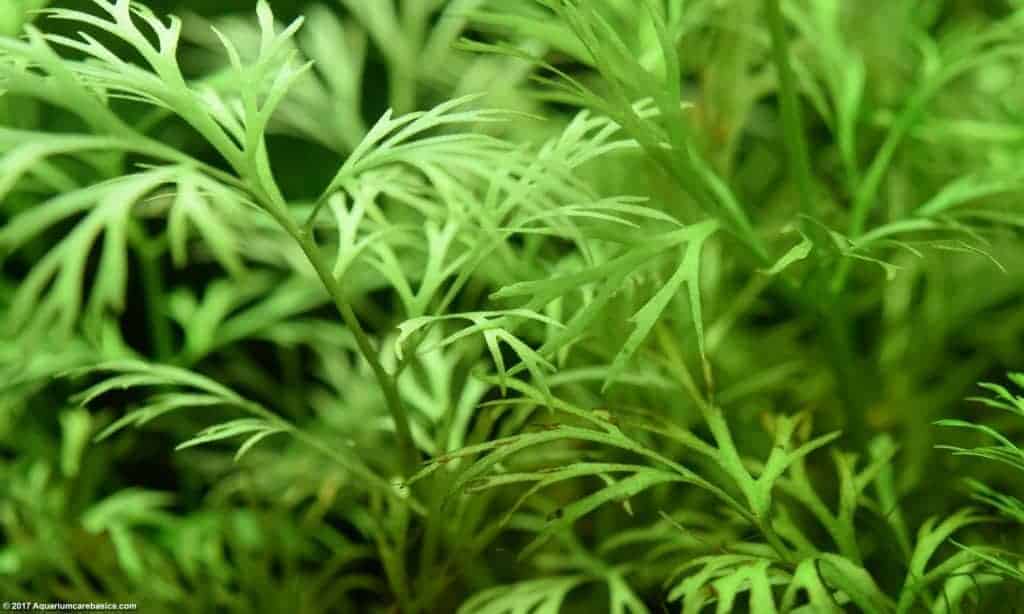
This is one of the most versatile of all aquarium plants since it can either be rooted in the substrate or float on the surface. When allowed to float, it has a more flattened appearance, with the leaves appearing slightly broader, while the white roots simply trail down in the water. Water-sprite’s coloration is variable, depending not only on the lighting conditions but also on the levels of dissolved nutrients in the water.
Bright lighting is essential if it is to thrive, but if the illumination is too intense, the leaves may become scorched and dieback. Water-sprite is not a long-lived plant, being effectively an annual. Mature leaves produce buds that ultimately give rise to new plants.
These may be separated from the parent plant once they are about 1.5 in (4 cm) across, but they can also be left to detach themselves. They will then float up to the surface and develop there naturally, sometimes protruding above the waterline.
Q&A
I had a good growth of Crystalwort in my tank, but over the summer it all died. What could have caused this?
Too high a temperature. If the waters get too hot, above 25°C (77°F) for more than a few days, then the plant tends to disintegrate.
Why are parts of my Butterfly Fern rotting?
The leaves are protected by fine hairs. Unfortunately, these hairs also retain any drops of condensation that fall from your cover glass. These cause the plant to rot.
Should I add fertilizer for my floating plants?
It may be necessary if you have a mass of them. They feed on the water, so use a liquid fertilizer. Take care, not to overdose and upset the balance of the tank. If you are doing regular water changes, though, it is not normally necessary to fertilize floating plants.
Duckweed is overrunning my tank and clogging the filter. How can I get rid Of this nuisance?
This is difficult. Scoop out as much as you can with a net. Then clean the tank and implements thoroughly, removing all traces of the plant from the pipes, covering glass, buckets, and even your hands. Rinse the nets you used in very hot water. If even small pieces remain, they will multiply again. Duckweed does have one saving grace – some larger cyprinids like to eat it!
I have some Water Lettuce on my indoor pond in the conservatory. It is getting infested with greenfly. Is there anything I can use to dispose of them?
Yes, but take great care. Insecticides are out, because they will kill the fish in your pond, but you could try cleaning the plants with a proprietary treatment. Alternatively, wash the greenfly off into the pond and let the fish eat them.

Hi, my name is Sean, and I’m the primary writer on the site. I’m blogging mostly about freshwater and saltwater aquariums, fish, invertebrates, and plants. I’m experienced in the fishkeeping hobby for many years. Over the years I have kept many tanks, and have recently begun getting more serious in wanting to become a professional aquarist. All my knowledge comes from experience and reading forums and a lot of informative sites. In pursuit of becoming a professional, I also want to inspire as many people as I can to pick up this hobby and keep the public interest growing.
Read more about Sean.
Please join also my Facebook group.

